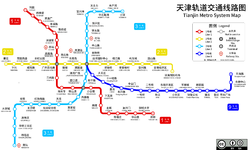Binhai Mass Transit
 |
|||
 
|
|||
| Overview | |||
|---|---|---|---|
| Locale | Tianjin, China | ||
| Transit type | Rapid transit | ||
| Number of lines |
5 operational |
||
| Number of stations | 112 | ||
| Daily ridership | 701,000 (2015 Avg.) 1,080,700 (2014 peak) |
||
| Annual ridership | 41.8 million (2010)(BMT excluded) | ||
| Website |
http://www.tjdt.cn http://www.ctbmt.cn/ |
||
| Operation | |||
| Began operation | 28 December 1984 (old system) 12 June 2006 (new system) |
||
| Operator(s) | Tianjin Metro General Corp. Tianjin Binhai Mass Transit Development Co., Ltd. |
||
| Technical | |||
| System length | 158.359 km (98 mi) | ||
| Track gauge | 1,435 mm (4 ft 8 1⁄2 in) standard gauge | ||
|
|||
| Tianjin Metro | |||||||
| Simplified Chinese | 天津地铁 | ||||||
|---|---|---|---|---|---|---|---|
| Traditional Chinese | 天津地鐵 | ||||||
|
|||||||
| Transcriptions | |
|---|---|
| Standard Mandarin | |
| Hanyu Pinyin | Dìtiě |
5 operational
1 under construction
The Tianjin Metro is the current rapid transit system in the city of Tianjin, which was the second city (after Beijing) in China to operate a subway system. Opened in 1984, the system now has 5 operating lines and 95 stations spanning over a total of 132.4 km. The lines are jointly operated by two rapid transit companies, namely the Tianjin Metro Group Co. Ltd and the Binhai Mass Transit Development Co. Ltd. The former mainly operates lines in the downtown, while the latter operates lines that serve the Binhai New Area and TEDA.
Tianjin, as an inland harbor of China, has long been a major commercial city. After the founding of the People's Republic in 1949, the number of vehicles on the roads significantly increased, causing pollution. To overcome these problems, the transport authority decided to close the old tram network and switch over to a rapid transit system.
However, due to economic costs, it was not until 1970 that construction of the system first took place. The first section, spanning 3.6 km of track and 4 stations, namely Xinhualu, Yingkoudao, Anshandao and Haiguangsi stations, was completed by February 1976. The second section, with an additional 1.6 km of track and the Xinanjiao and Erweilu stations, was completed by 1980. After construction resumed, the total length was 7.4 km, with 8 stations, and service on the line began on December 28, 1984.
To reduce construction costs, the transport authority decided to use an abandoned canal bed to form part of the system, and did not dig deeply. By using the canal bed, the underground section is only 2–3 meters under the street surface, and was the world's shallowest metro. There were only 1,000 full-time construction workers at that time; the others were volunteers from factories, schools and institutions all over the city. The average number of volunteer workers exceeded 2,000 a day, which rendered the project unique in the world then. Construction was delayed in 1976 when an earthquake hit the city, but was resumed in 1979 and completed by 1984.
...
Wikipedia

